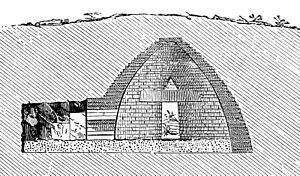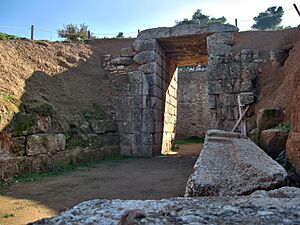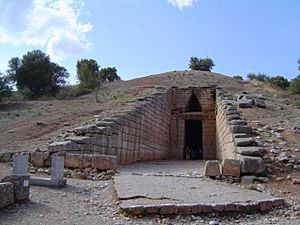Beehive tomb facts for kids


A beehive tomb, also known as a tholos tomb, is a special kind of ancient burial place. It gets its name because it looks like a beehive! These tombs have a unique false dome shape. This dome is made by stacking rings of mudbricks or stones, with each new ring placed a little bit closer to the center than the one below it. This creates a smooth, rounded ceiling.
People in different cultures around the Mediterranean Sea and West Asia used tholos tombs for burials. But sometimes, these structures were used for other things too. For example, in Cyprus, they were homes. In Bulgaria and Syria, they were used for rituals. And in Spain and Sardinia, they were even part of forts!
Contents
Ancient Greece: Grand Beehive Tombs
In Greece, the large, domed tholoi were built during the Late Bronze Age. Experts still debate where these tombs first came from. Some think they were inspired by older tholoi in Crete. Others believe they grew naturally from earlier tumulus burials (mounds of earth over graves) from the Middle Bronze Age.
These beehive tombs are similar to the many Mycenaean chamber tombs, which appeared around the same time. Both types of tombs have a main room, a doorway (called a stomion), and an entrance passage (called a dromos). The main difference is that tholoi are mostly built from stones, while chamber tombs are usually carved out of rock.
Early Greek Tholoi
Some of the earliest tholoi have been found in Messenia, in southwest Greece. An example is at Voidhokoilia. These early tombs were built on flat ground and then covered with a mound of earth. At Marathon, Greece, two similar mounds show how a rectangular room could be built and then given an entrance passage.
After about 1500 BCE, beehive tombs became much more common. You can find them all over the Mycenaean heartland (the main area where the Mycenaean civilization lived). Unlike the early ones, these later tombs were almost always dug into the side of a hill. This meant that only the top part of the domed room was above ground. This visible stone part was then hidden by a small mound of earth.
Inside the Tombs
These tombs usually held more than one burial. Bodies were placed in different spots: on the floor, in special pits, or on stone benches. Many valuable grave goods (items buried with the dead) were also found. After a burial, the tomb's entrance was filled with soil. This left only a small mound visible, with most of the tomb hidden underground.
The main room of the tomb was always built with masonry (carefully cut and fitted stones), even in the oldest examples. The doorway (stomion) was also made of stone. In early tombs, the entrance passage (dromos) was often just cut out of the natural rock, like at the Panagia Tomb in Mycenae. But in later, grander tombs like the Treasury of Atreus and the Tomb of Clytemnestra (both at Mycenae), all three parts – the room, the doorway, and the passage – were built with very fine ashlar masonry (perfectly cut and shaped stones).
The domed rooms were built using a technique called corbelling. This means layers of stone were placed closer together as the dome narrowed towards the top. The inside of these stone layers was then smoothed to create a perfect dome shape.
Wealth and Importance
The entrances to these tombs were a great way to show off wealth. For example, the entrance to the Treasury of Atreus was decorated with columns made of red and green stone. This stone, called “Lapis Lacedaimonius,” was brought from quarries over 100 kilometers away!
There were so many of these tombs, often more than one near a single settlement, that it suggests they weren't just for kings. However, the huge size of the largest tombs (which could be 10-15 meters wide and tall) would have cost a lot of money. This suggests that the biggest ones were likely built for royal families. Even though many of these tombs were robbed long ago, both in ancient times and more recently, the larger ones still contained some of the richest finds from the Late Bronze Age in Greece. For instance, the Vapheio tholos, south of Sparta, had been robbed. But two hidden pits in the floor were missed. These pits held, among other treasures, two gold “Vapheio cups” decorated with scenes of bull taming. These cups are some of the most famous Mycenaean treasures.
Levant and Cyprus: Circular Buildings
Circular buildings were common in the Near East. Some of these, called tholoi, were found in the Neolithic Halaf culture in Iraq, Syria, and Turkey. They were probably used as both houses and storage places, but they might have also been used for rituals. Later examples are found in Cyprus (at Khirokitia), where they served as homes. There isn't a clear link between these early circular homes and the later tholos tombs.
Southern Europe and Sardinia: Megalithic Tombs
In the Chalcolithic period (Copper Age) in the Iberian peninsula (Spain and Portugal), beehive tombs appeared around 3000 BCE. They were a new type of "megalithic" (large stone) structure. They are very common in southern Spain and Portugal. However, in central Portugal and southeastern France, other styles, like artificial caves, were preferred. The ancient civilizations of Los Millares and its successor, El Argar, are especially known for this type of burial.
The Bronze Age forts called motillas in La Mancha (Spain) also used the tholos building method.
Sardinia's Nuraghi
The impressive stone structures known as nuraghi dominated the Bronze Age landscape of Sardinia (Italy). Similar structures are also found in southern Corsica. Nuraghi are like tall, cone-shaped towers made of dry-laid stone (stones placed without mortar). They are about 40 feet wide at the bottom and slope up to a circular roof about 50 feet above the ground. The domed ceiling inside is 20 to 35 feet above the floor. About 7,000 nuraghi have been found, but it's believed that as many as 30,000 might have been built!
There are also Etruscan tombs at a burial ground called Banditaccia from the 6th and 7th Centuries BCE. These tombs look like beehives from the outside. But inside, they are decorated and furnished to look like Etruscan homes.
Bulgaria: Thracian Royal Tombs
The beehive Thracian Tomb of Kazanlak is a famous example of the richly decorated tholoi tombs of Thracian rulers. Many such tombs are found in modern Bulgaria and date from the 4th to 3rd century BC. The walls of the Kazanlak tomb are covered with plaster and stucco, showing detailed scenes from the life of the person buried there.
Other tumuli (burial mounds), known as mogili in Bulgarian, also have underground rooms shaped like beehive domes. These include the Thracian Tomb of Sveshtari, Thracian tomb of Aleksandrovo, Golyama Arsenalka, Tomb of Seuthes III, Thracian tomb Shushmanets, Thracian tomb Griffins, Thracian tomb Helvetia, and Thracian tomb Ostrusha. Many important gold and silver treasures have been found in these Thracian tombs. They are now kept in Bulgaria's Archaeological and National Historical Museum and other places.
Eastern Arabia: Ancient Tombs in the Desert
The earliest stone-built tombs that look like "beehives" are found in Oman and the U.A.E.. They were built from flat stones found in the area. These tombs date back to the Hafit period of the early Bronze Age, between 3,500 and 2,500 years BCE. During this time, the Arabian Peninsula had much more rainfall than it does now. A thriving civilization lived in what is now desert, west of the Hajar Mountains along the Gulf of Oman.
No human remains have ever been found in these "tombs," but it's hard to imagine another purpose for them. They only look a little bit like the Greek tombs because they are circular. However, they are built entirely above ground and don't have the same three-part structure (room, doorway, passage). Their entrances are usually just part of the circular wall.
Today, you can find these tombs in three main areas:
- The Al-Hajar Region (especially Jebel Hafeet near Al Ain in the U.A.E., and the Archaeological Sites of Bat, Al-Khutm and Al-Ayn in Oman).
- The Hat Region.
- The Hadbin area near Barkaʾ.
The Hajar tombs are very numerous. Some have been restored, allowing you to crawl into the center of a tall stone structure that is about 5-6 meters (16-20 feet) across.
Images for kids
-
Beehive tombs from the Hafit period (about 5000 years ago), near Jebel Hafeet in Al Ain, U.A.E.
See also
- Beehive house
- Mycenaean Greece
- Nuraghi
- Tholos of Delphi
- Minoan sites with tholos tombs: Armeni, Archanes-Phourni, Hagia Photia, Kamilari, Kavousi Vronda, Nea Roumata, Papoura, Phylaki, Stilos, Yerokambos



